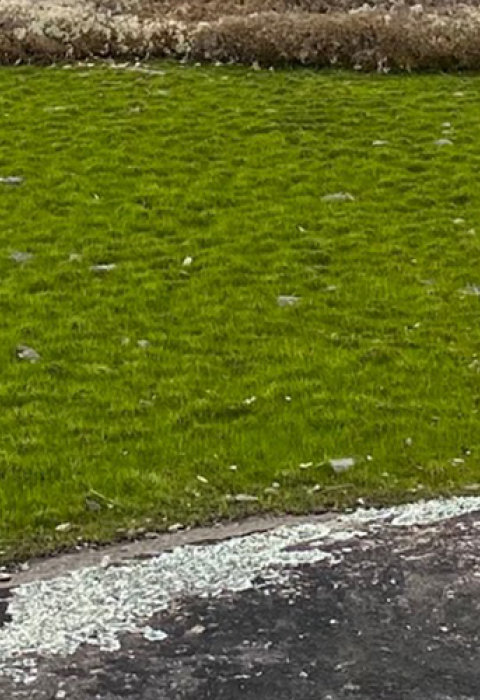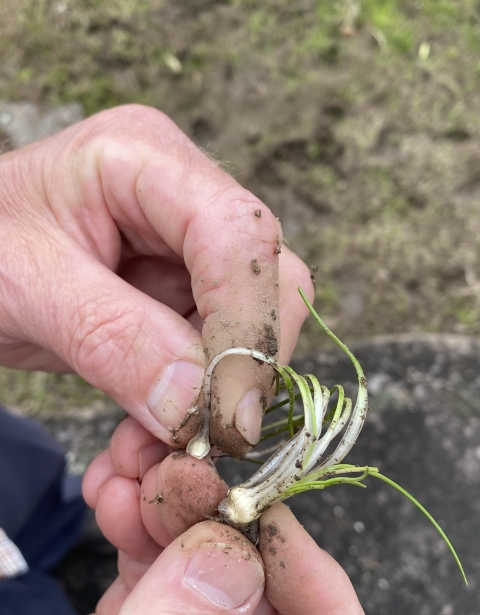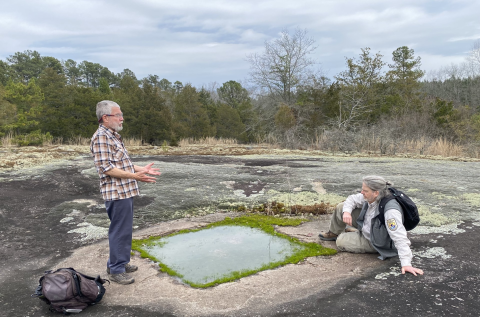Appling, Georgia – It's just a rock.
No, no, it’s much more, says James “Mincy” Moffett, a botanist. Heggie’s Rock is a pluton, a monadnock, “a bubble of magma,” a rock island, and a hundred-acre granitic outcrop towering over the forested Piedmont below.
It’s also a mystical moonscape with an otherworldly look and feel.
“I don’t like the moonscape description,” says Moffett, a biologist with the U.S. Fish and Wildlife Service in Athens. “It is not devoid of life.”
It is full of life, if you look closely, with rare plants seen virtually nowhere else, including the federally endangered mat-forming quillwort and the federally threatened pool sprite. The dainty, ephemeral plants survive in small, usually circular, ephemerally wet pockets of indented granite whose nearby temperatures can reach a very inhospitable 140 degrees. Their beauty and fragility belie their strength.
“It’s a tough place to make a living,” Moffett says during a spring hike across the hundred-acre Heggie’s Rock Preserve outside Augusta.
They need help to survive. The Service, along with The Nature Conservancy (or TNC, which owns the off-limits preserve), and the Atlanta Botanical Garden, has repeatedly “enhanced” the very shallow pools that are home to the delicate flowers. They’ve transplanted quillworts from other rocky outcrops. They’ve added soil to the pools. They’ve built mini-concrete dams for the same purpose. And they’ve deployed jackhammers and diamond-blade saws to deepen the pools, both here and at four other rocks, including Stone and Arabia mountains nearer Atlanta.
Are they playing God? Moffett prefers a Johnny Appleseed analogy, propagating species that would otherwise blink out. He also respects “guerilla botany” which, historically, has saved many plants. (This from a guy who used to rappel down tall buildings for Greenpeace unfurling pro-environment banners.) Malcolm Hodges prefers “zookeepers,” caring for animals in a semi-controlled environment.
“We think that this ensures the survival of this species on Heggie’s Rock well beyond the zombie apocalypse,” says Hodges, a retired TNC biologist who stewarded the nonprofit’s Georgia holdings for two decades.
A ‘Lilliput world’
So special is Heggie’s Rock that the U.S. Secretary of the Interior in 1980 designated it a National Natural Landmark National Natural Landmark
The National Natural Landmarks Program preserves sites illustrating the geological and ecological character of the United States. The program aims to enhance the scientific and educational value of the preserved sites, strengthen public appreciation of natural history and foster a greater concern for the conservation of the nation’s natural heritage. The program was established in 1962 by administrative action under the authority of the Historic Sites Act of 1935. The first National Natural Landmarks were designated in 1963. Today, there are more than 600 National Natural Landmarks in 48 states, American Samoa, Guam, Puerto Rico and the U.S. Virgin Islands.
Learn more about National Natural Landmark , one of 604 “outstanding biological and geological resources” across the country.
“It is like stepping into an Alice in Wonderland-Lilliput world,” says Jennifer Ceska, the conservation coordinator for the State Botanical Garden of Georgia at the University of Georgia. “Everything is miniaturized. You have hundreds, if not thousands of rare and endangered plants in big patches. When you stand on that dome you feel the vastness of the site. It’s just absolutely, strikingly beautiful. And it’s singular to Georgia, and to the Southeast.”
The granite outcrops of the southeastern Piedmont are easy to spot from the road or the air, huge rocks jutting up from the flatlands filled with oaks and pines, or condos and warehouses. They range from eastern Alabama through Georgia and South Carolina before petering out in North Carolina and Tennessee. These stand-alone protuberances support a suite of endemic species, including Spooner’s flightless midge found only atop Heggie’s Rock. Lichen- and moss-covered rocks, patches of scrub, herbs, and sedges, and wind-stunted cedars fill the otherwise barren surface.
It is the vernal pools, or dish gardens, though, that mesmerize. Ranging in depth from one half to three inches, with a thin coating, at best, of nutrient-rich soil, the naturally eroded depressions support the rarest of plants. From afar, and in the spring, they look like small, multi-colored carpets.
A colony of mat-forming quillwort, up close, resembles a green brain. Its slender, chive-like leaves grow up, out, and over, and clump together. Crevices, or grooves, separate the wrinkled tufts into a maze-like pattern that resembles the labyrinthine cerebrum.
The pool sprite is a dandy of a white flowering herb with green leaves shaped like lances under water and egg-like leaves floating on top. The flowers bloom above and below water. The sprite also comes with a more Gulliver-esque name: snorkelwort.
“That's a nice dish garden there,” says Moffett along Heggie’s Rock’s eastern edge. “Those pairs of leaves with little white flowers. Look at the water on the rock. You could be looking at the tundra. It's lovely.”
Adds Hodges, “Those little green plants are coming up in pools where I didn’t see them before. We’ve had such a wet winter and an early spring.”
The harsh, exposed environment explains the flowers’ at-risk status. The quillworts, for example, live within the rock-rimmed pools near the rock’s summit where water comes from direct rainfall rather than run-off. Pool sprites also depend upon enclosed rock circles that capture water, yet their life cycles – germination, flowering, fruiting, death – last maybe a month. In dry years, the sprites may not appear at all. Quillworts, too, live only a few, fleeting, ephemeral weeks.
Only 10 populations of mat-forming quillworts survive; only 42 populations of pool sprites do. Both are found at Heggie’s Rock.
“Heggie’s Rock is the best example in eastern North America of the remarkable endemic flora restricted to granite outcrops,” the National Park Service writes. “The site is the least disturbed of all the major outcrops.”
‘A huge success’
Archibald Heggie, a Scotsman, married a Columbia County woman in the early 1800s and acquired the rock as part of her dowry. As Georgia grew, so did demand for granite from the outcrops. Quarry companies owned the land since the 1950s, but never mined it. Robert Pollard, a lumber company executive with a conservationist’s bent, bought the rock in 1981. He sold it to TNC two years later.
The conservancy put up a gate to protect the rock, but the public still found ways to get in and damage the sensitive dish gardens. Hikers, horseback riders, picnickers, ATV riders, and trash-dumpers tramped, and trampled, the grounds. Granite outcrops nearer to Atlanta succumbed to sprawl. Two pool-sprite bearing ponds at Rock Chapel Mountain in Lithonia were lost a generation ago when a highway was widened. (The Endangered Species Act required the transportation department to mitigate the damage by financing similar outcrop habitat in west Georgia.)
Many of the existing granite monadnocks in Georgia are protected by the state, feds, nonprofits, or private entities. Quarrying, though, still threatens the unprotected quillworts, pool sprites and other rare species. Yet the ravages of climate change climate change
Climate change includes both global warming driven by human-induced emissions of greenhouse gases and the resulting large-scale shifts in weather patterns. Though there have been previous periods of climatic change, since the mid-20th century humans have had an unprecedented impact on Earth's climate system and caused change on a global scale.
Learn more about climate change – more heat, more droughts, more powerful downpours that scour soil and plants from rocky tops – pose existential threats to the delicate flowers.
What to do?
Johnny Appleseed to the rescue.
Sometime in the late 1980s, mat-forming quillworts were dug up from a nearby open pit mine and transplanted into two vernal pools on Heggie’s Rock. Miniature concrete walls, or dams, were erected to keep the precious water in place.
“A few sprigs of quillwort were planted here and now it’s all filled in,” Hodges says alongside a botanically robust shallow pool as mining machines rumble in the distance. “We want to recreate the natural processes. It's sort of a desperate act to move them, but we’re ensuring the survival of the species.”
Beginning in 2016, three other pools able to retain water were deepened with jackhammers and saws by TNC, the Service, and the Atlanta Botanical Garden. Native soil was then placed in the water-holding pools and quillworts and pool sprites were transplanted.
In all, across five Piedmont outcrops, 21 new pools were created with transplants of these species, as well as the botanically related black-spored quillwort, according to a soon-to-be-released report by Anna Wyngaarden, a PhD candidate at the University of Georgia.
“In general, the efforts reported here have been a huge success with most of the established populations still persisting a decade later,” Wyngaarden writes. “These efforts have been informed and inspired by a handful of trail-blazing individuals and reflect a successful conservation story of multi-institutional collaboration and creativity.”
As for Heggie’s Rock, in particular: “All of the enhanced pools at Heggie’s Rock have been successfully established with I. tegetiformans (quillwort), G. amphiantha (pool sprites), or both, in each.”
‘New lease on life’
Transplanting species, as well as manufacturing habitat, raises ethical questions. Should biologists determine which species live or die? Should they physically manipulate an ecosystem for the benefit of one or two species? What impact does that have on other species in both the new and old habitats?
“We humans have changed Georgia and the Southeast so much that we have a responsibility to get in there and try to keep this diversity on the land,” says Ceska, who’s also the conservation coordinator for the Georgia Plant Conservation Alliance. “Choosing which species get managed is really hard. It’s something we wrestle with every year. Can we give these species a new lease on life?”
Conversely, is it ethically proper for biologists to let species go extinct without trying to save them? And doesn’t climate change – another man-made threat to plants and animals – require them to act?
Hodges and Moffett stop by the pool where the first quillworts were transplanted in the 1980s. It's a larger pool, covered in quillworts and pool sprites. Moffett gets down on hands and knees for a closer look.
“I’m okay with the outcome to be sure,” he says. “And I’ll recommend we do more of this because we have a track record that it works, and we’re running out of time. We can’t remain purists anymore. If we don’t manage the species, we’ll lose them.”





